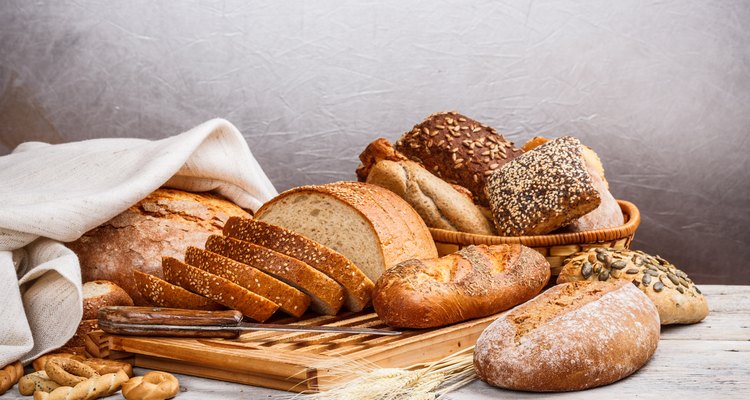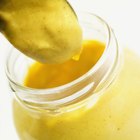
grafvision/iStock/Getty Images
Whole wheat bread began to gain popularity in the 1960s and '70s as U.S. consumers grew tired of the fluffy, processed, white flour loaves that dominated supermarket shelves. Master baker and author Peter Reinhart credits both the counterculture movement and Elizabeth David's 1977 book "English Bread and Yeast Cookery" with "spawning a whole-grain renaissance in Great Britain and inspiring bakers on this side of the Atlantic as well." Like white bread, wheat bread at its most basic uses four ingredients, with some important modifications.
Flour
The foundation of wheat bread is, of course, wheat flour, which is ground using the whole wheat berry, and includes the outer bran layer, the inner germ and endosperm in between. White flour, by contrast, comes from just the endosperm. You can buy wheat flour in a variety of textures, from fine to coarse grind, and made from hard or soft wheat. Reinhart recommends using hard wheat flour for bread. Wheat flour by nature produces a denser, heavier loaf than white flour, so some bakers lighten the texture by using half white and half wheat flour. Multigrain recipes include additional grains such as oats, barley or rice.
Liquid
Bread recipes must include some kind of liquid to activate the yeast that leavens the dough. In white bread recipes, that liquid is usually warm water, and the same is true of wheat bread. However, even simple wheat bread recipes often incorporate additional liquids to enhance their flavor, which can produce a bitter taste due to the presence of wheat bran in the flour. These liquids can be almost anything, including milk, olive oil, fruit juices, honey and agave nectar.
Yeast
As with any leavened bread, yeast makes the dough rise. Available in granule or moist cake form, yeast consumes the sugars in wheat flour and produces bubbles of carbon dioxide that "inflate" the dough. Yeast dough recipes might call for the addition of yeast during the mixing stage, or specify the use of a pre-fermented starter, usually a mixture of a small amount of flour, yeast and water that must first develop for several hours or overnight. You might see such a starter referred to in a recipe as "pre-ferment," "barm," "sponge," "biga" or "poolish."
Salt and Other Flavorings
Salt moderates yeast development and adds flavor to wheat dough. Wheat breads might also include molasses for color, as well as any number of additives to add texture and flavor. Common additions include nuts, seeds such as sesame and poppy, herbs, wild or brown rice, aromatic ingredients such as onion and garlic, and chopped dried fruit.
Related Articles

Can I Substitute Bleached for ...

How to Cook Tapioca Flour to Make Bread
What Is the Difference Between Cake ...

What Are the Functions of Flour in ...

How to Make Bread Tender

Do You Still Need Baking Powder & Salt ...
Quick and Easy French Bread Recipe

Does It Matter if I Substitute Baking ...

What to Do With Pizza Dough When You're ...

Main Ingredients of English Muffins

How to Cook With Filo Dough

What Is Mustard Flour?

Can You Proof Yeast in Warm Milk?
Can You Refrigerate Homemade Yeast ...
Is Unbleached Flour the Same as ...

What Additives Are in Flour?

What Kind of Oil Do You Use in Brownie ...

Bread Flour vs. Cake Flour in Sponge ...

Can You Make Dumplings With Corn Starch?

Substitute for Gram or Besan Flour
References
- "Crust and Crumb: Master Formulas for Serious Bakers"; Peter Reinhart; 2006
- King Arthur Flour: King Arthur's 100 Percent Whole Wheat Sandwich Bread
Writer Bio
Bryn Bellamy has written professionally since 1999 and specializes in food & drink, travel, outdoor recreation, nutrition and general features. She has a background in restaurant management and hotel catering, was a features editor for Gannett, and was nominated for a James Beard Award for Food & Drink design and editing. She holds a Bachelor of Arts in journalism from the University of Southern California.
Photo Credits
grafvision/iStock/Getty Images